Physical Address
304 North Cardinal St.
Dorchester Center, MA 02124
See Chapter 19 .
See Chapter 16, Chapter 43 .
Paired oculomotor nuclei are located in the dorsal midbrain ventral to the periaqueductal gray matter at the level of the superior colliculus. Each nucleus is composed of a superior rectus subnucleus providing innervation to the contralateral superior rectus; inferior rectus, medial rectus, and inferior oblique subnuclei providing ipsilateral innervation; and an Edinger-Westphal nucleus supplying preganglionic parasympathetic output to the iris sphincter and ciliary muscles ( ; ![]() eFig. 103.1 ). A single midline caudal central subnucleus provides innervation to both levator palpebrae superioris muscles.
eFig. 103.1 ). A single midline caudal central subnucleus provides innervation to both levator palpebrae superioris muscles.
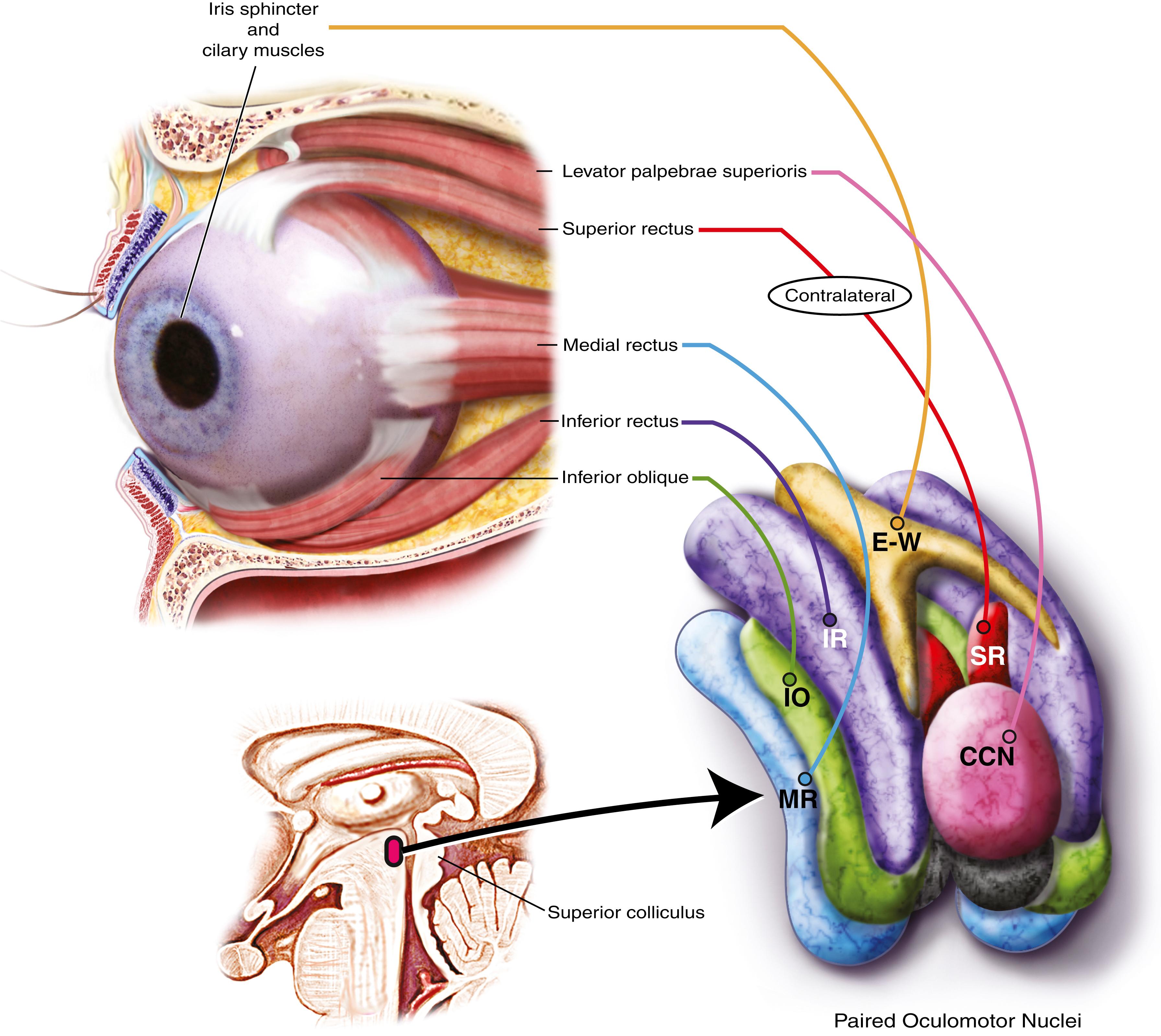
A third nerve fascicle originates from the ventral surface of each nucleus and traverses the midbrain, passing through or near to the red nucleus and in close proximity to the cerebral peduncles before emerging ventrally as rootlets in the lateral interpeduncular fossa. In the interpeduncular fossa, the rootlets converge into a third nerve trunk that continues ventrally through the subarachnoid space toward the cavernous sinus, passing between the superior cerebellar artery and the posterior cerebral artery. It travels parallel to the posterior communicating artery (PCOM) and is very near to this vessel at the vessel’s junction with the intracranial internal carotid artery. In the cavernous sinus, the third nerve is located within the dural sinus wall, just lateral to the pituitary gland. From the cavernous sinus, the third nerve enters the orbit via the superior orbital fissure. Just prior to entry, the nerve anatomically divides into superior and inferior divisions in the anterior cavernous sinus, although careful evaluation of brainstem lesions and their corresponding patterns of pupil and muscle involvement suggests that functional division occurs in the midbrain ( ; ). Within the orbit, the superior division innervates the superior rectus and the levator palpebrae superioris, and the inferior division innervates the inferior and medial recti, the inferior oblique, and the iris sphincter and ciliary muscles ( Fig. 103.2 ). Prior to innervating the ciliary and sphincter muscles as the short ciliary nerves, parasympathetic third nerve fibers synapse in the ciliary ganglion within the orbit (see Fig. 103.2 ).
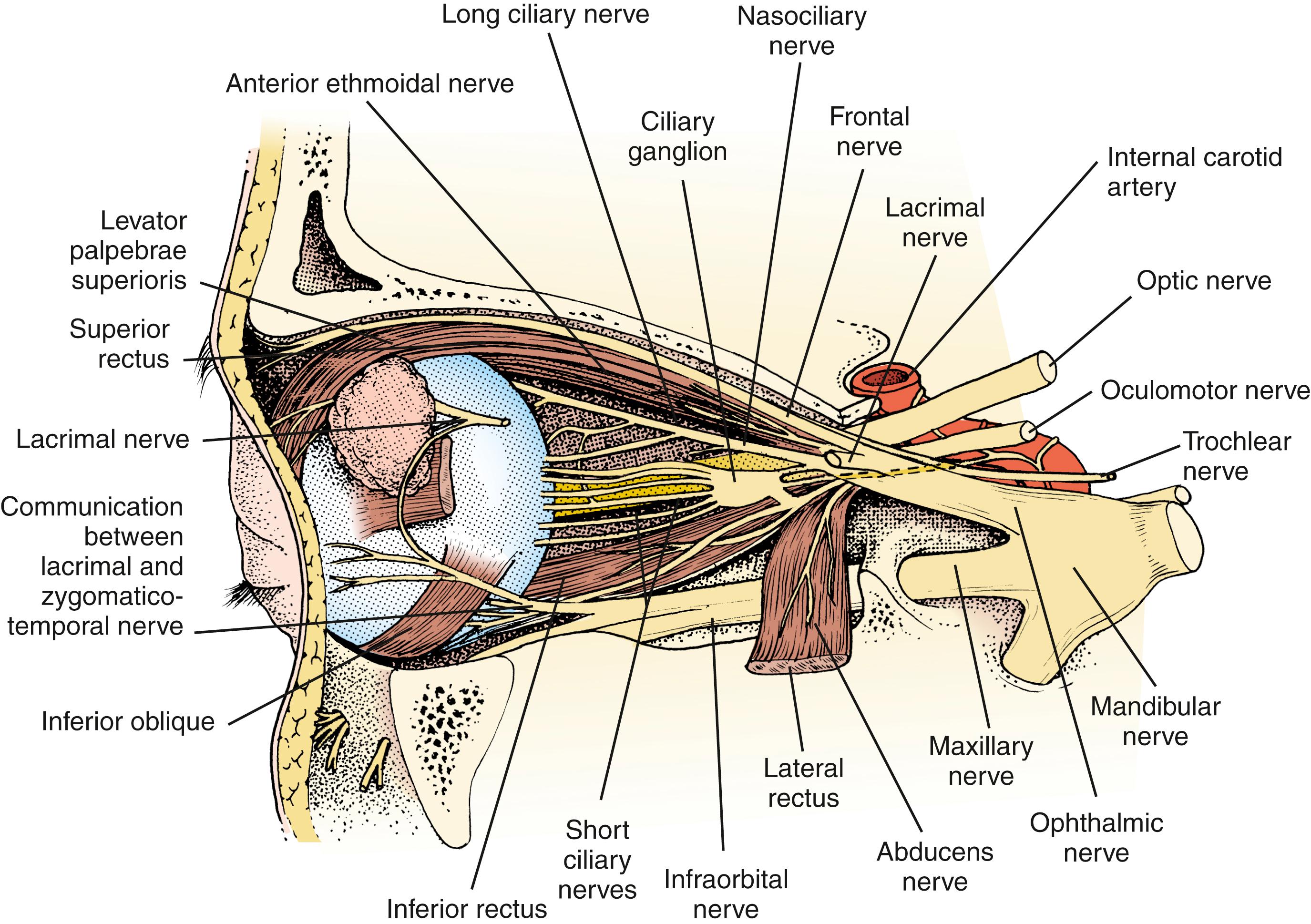
In addition to potentially causing ipsilateral weakness of the medial rectus, inferior rectus, and inferior oblique muscles, an oculomotor nuclear lesion may result in bilateral superior rectus weakness. Ipsilateral subnucleus involvement affects the contralateral superior rectus because of the completely crossed nature of superior rectus innervation (see ![]() eFig. 103.1 ). A unilateral oculomotor nuclear lesion may affect these unilateral originating fibers destined for decussation, as well as those fibers that originated contralaterally and are already decussated. If the single midline levator palpebrae superioris subnucleus is involved in an oculomotor nuclear lesion, bilateral ptosis results. Isolated bilateral ptosis or isolated paresis of a single extraocular muscle is also possible from a small focal nuclear lesion, given the functional division of the subnuclei ( ). Involvement of the rostral and dorsally located Edinger-Westphal nucleus will lead to pupil involvement. Common brainstem lesions include ischemia, hemorrhage, demyelination, infectious and noninfectious inflammation, and neoplasm.
eFig. 103.1 ). A unilateral oculomotor nuclear lesion may affect these unilateral originating fibers destined for decussation, as well as those fibers that originated contralaterally and are already decussated. If the single midline levator palpebrae superioris subnucleus is involved in an oculomotor nuclear lesion, bilateral ptosis results. Isolated bilateral ptosis or isolated paresis of a single extraocular muscle is also possible from a small focal nuclear lesion, given the functional division of the subnuclei ( ). Involvement of the rostral and dorsally located Edinger-Westphal nucleus will lead to pupil involvement. Common brainstem lesions include ischemia, hemorrhage, demyelination, infectious and noninfectious inflammation, and neoplasm.
A complete oculomotor nerve palsy has the following ipsilateral examination features: eye deviation inferiorly and laterally (“down and out”); absence of ocular elevation, depression, and adduction; and complete ptosis. A complete oculomotor palsy may be further described as complete involving the pupil with an enlarged and nonreactive pupil or as a pupil-sparing otherwise complete oculomotor palsy. A partial, or incomplete, third nerve palsy may present with any combination of deficits of third nerve innervated structures. Great emphasis is often placed on the presence of pupil involvement versus pupil sparing with regard to probable lesion etiology; however, neither this, nor the presence or absence of pain or other demographic features can fully rule out potential neurologically devastating emergent etiologies, such as a PCOM aneurysm or pituitary apoplexy ( ; ) (see section below on Interpeduncular Fossa and Subarachnoid Space and section on Isolated Oculomotor Nerve Palsy).
Claude syndrome is the combination of an ipsilateral oculomotor nerve palsy and contralateral hemiataxia ( Table 103.1 and ![]() , ; ). Although historically the syndrome was described as involving the oculomotor fascicle and the red nucleus, the ataxia is likely due to involvement of the superior cerebellar peduncle at the caudal end of the red nucleus or the pedunculopontine nucleus, a component of the mesencephalic locomotor region ( ). Nothnagel syndrome is the combination of ipsilateral oculomotor nerve palsy and ipsilateral hemiataxia from involvement of the oculomotor fascicle and superior cerebellar peduncle or pedunculopontine nucleus (see Table 103.1 ). Weber syndrome is the combination of an ipsilateral fascicular oculomotor nerve palsy and contralateral hemiparesis from cerebral peduncle involvement (see Table 103.1 ). Benedikt syndrome involves the oculomotor fascicle and red nucleus, causing an ipsilateral oculomotor nerve palsy and contralateral chorea or tremor (see Table 103.1 ). Common brainstem lesions include ischemia, hemorrhage, demyelination, infectious and noninfectious inflammation, and neoplasm ( ; ).
, ; ). Although historically the syndrome was described as involving the oculomotor fascicle and the red nucleus, the ataxia is likely due to involvement of the superior cerebellar peduncle at the caudal end of the red nucleus or the pedunculopontine nucleus, a component of the mesencephalic locomotor region ( ). Nothnagel syndrome is the combination of ipsilateral oculomotor nerve palsy and ipsilateral hemiataxia from involvement of the oculomotor fascicle and superior cerebellar peduncle or pedunculopontine nucleus (see Table 103.1 ). Weber syndrome is the combination of an ipsilateral fascicular oculomotor nerve palsy and contralateral hemiparesis from cerebral peduncle involvement (see Table 103.1 ). Benedikt syndrome involves the oculomotor fascicle and red nucleus, causing an ipsilateral oculomotor nerve palsy and contralateral chorea or tremor (see Table 103.1 ). Common brainstem lesions include ischemia, hemorrhage, demyelination, infectious and noninfectious inflammation, and neoplasm ( ; ).
| Syndrome ∗ | Symptoms and Signs | Involved Structures |
|---|---|---|
| Claude | Ipsilateral III | III—brainstem fascicle |
| Contralateral ataxia | Red nucleus/superior cerebellar peduncle | |
| Nothnagel | Ipsilateral III | III—brainstem fascicle |
| Ipsilateral ataxia | Superior cerebellar peduncle | |
| Weber | Ipsilateral III | III—brainstem fascicle |
| Contralateral hemiparesis | Cerebral peduncle | |
| Benedikt | Ipsilateral III | III—brainstem fascicle |
| Contralateral chorea or tremor | Red nucleus | |
| Tolosa-Hunt | Ipsilateral III, IV, VI | Cavernous sinus |
| Ipsilateral first and second branches of V | III, IV, VI, first and second branches of V | |
| Ipsilateral Horner syndrome | Sympathetic nerves | |
| Wallenberg lateral medullary syndrome | Ipsilateral facial numbness and ↓ pinprick | Spinal trigeminal tract and nucleus |
| Contralateral hemibody ↓ pain and temperature | Spinothalamic tract | |
| Dysphagia and ↓ gag reflex | Nucleus ambiguus | |
| Limb ataxia | Inferior cerebellar peduncle | |
| Horner syndrome | Sympathetic nerves | |
| Vertigo | Vestibular nuclei | |
| Opalski syndrome | Wallenberg in addition to ipsilateral hemiparesis | Corticospinal fibers caudal to pyramidal decussation |
| Gradenigo | Facial and mastoid area pain | Petrous apex—temporal bone V, VI, VII |
| Ipsilateral 1st branch of V | ||
| Ipsilateral VI and VII | ||
| Foville | Ipsilateral VI and VII | VI and VII—brainstem |
| Contralateral ataxia | Mid-cerebellar peduncle | |
| Ipsilateral Horner syndrome | Sympathetic nerves | |
| Ipsilateral deafness | Vestibulocochlear nerve/fascicle | |
| Ipsilateral ↓ taste and facial sensation | Spinal trigeminal tract/nucleus solitarius | |
| Millard-Gubler | Ipsilateral VI and VII | VI and VII—brainstem |
| Contralateral hemiparesis | Pyramidal tract | |
| Raymond | Ipsilateral VI | VI—brainstem |
| Contralateral hemiparesis | Pyramidal tract | |
| Bell’s palsy | VII | VII—intratemporal nerve and geniculate ganglion |
| Ramsay Hunt | VII | VII |
| Vesicular otic or oral rash ± ↓ hearing | ±VIII | |
| Melkersson-Rosenthal | VII | VII—distal branches |
| Facial edema | ||
| Fissured tongue | ||
| Eagle | IX | XI—elongated styloid process or ossified stylohyoid ligament |
| Vernet | IX, X, XI | Jugular foramen |
| Villaret | IX, X, XI | Jugular foramen |
| XII | Hypoglossal canal | |
| Horner syndrome | Sympathetic nerves | |
| Collet-Sicard | IX, X, XI | Jugular foramen |
| XII | Hypoglossal canal | |
| Avellis | X | X—brainstem or peripheral |
| Contralateral hemiparesis | Pyramidal tract | |
| Tapia | X and XII | X and XII—brainstem or peripheral |
| Dejerine medial medullary syndrome | Ipsilateral XII | XII—nuclei or fascicle |
| Contralateral hemiparesis | Pyramidal tract | |
| Contralateral hemisensory deficit | Medial lemniscus | |
| Babinski-Nageotte | Combined symptoms and signs of Wallenberg and Dejerine syndromes | Hemi-medullary: lateral and medial medulla |
∗ Descriptions of named syndromes vary slightly, depending on reference used.
Large Left Hypertropia Secondary to Right Oculomotor Nerve Palsy.
Left Appendicular Ataxia.
The most common etiology of oculomotor dysfunction in this region is compression by a PCOM aneurysm ( ). Pupillary fibers are located superomedially near the surface of the nerve and are particularly prone to compression by a PCOM aneurysm. As a result, “rules” with regard to interpretation of pupillary involvement have been defined to guide diagnostic evaluation. These will be reviewed for completion’s sake, though it is now fairly well accepted that all oculomotor palsies warrant imaging evaluation for a PCOM aneurysm ( ; ; ). Without controversy, any pupil-involving or pupil-sparing incomplete oculomotor palsy requires immediate evaluation for a PCOM aneurysm, given the high risk of subarachnoid hemorrhage and mortality if left undiagnosed and untreated ( ; ). Some patients with an aneurysmal incomplete oculomotor nerve palsy will lack pupillary involvement at initial presentation, but the majority will progress to pupillary involvement within 1 week. Spontaneous improvement in oculomotor nerve function may occur with an aneurysm and should not preclude diagnostic testing. A pupil-sparing otherwise complete oculomotor palsy is exceedingly unlikely to result from PCOM aneurysmal compression and the urgency of imaging in this setting is controversial ( ; ). However, immediate imaging is favored to avoid errors in exam interpretation that increase the risk of a missed diagnosis with high morbidity and mortality and because both basilar aneurysm and pituitary apoplexy have been reported with pupil-sparing otherwise complete oculomotor palsy ( ; ). Onset of oculomotor dysfunction following mild-moderate head trauma should also prompt investigation for an underlying aneurysm, though one may not always be found ( ; ; Fig. 103.3 ).
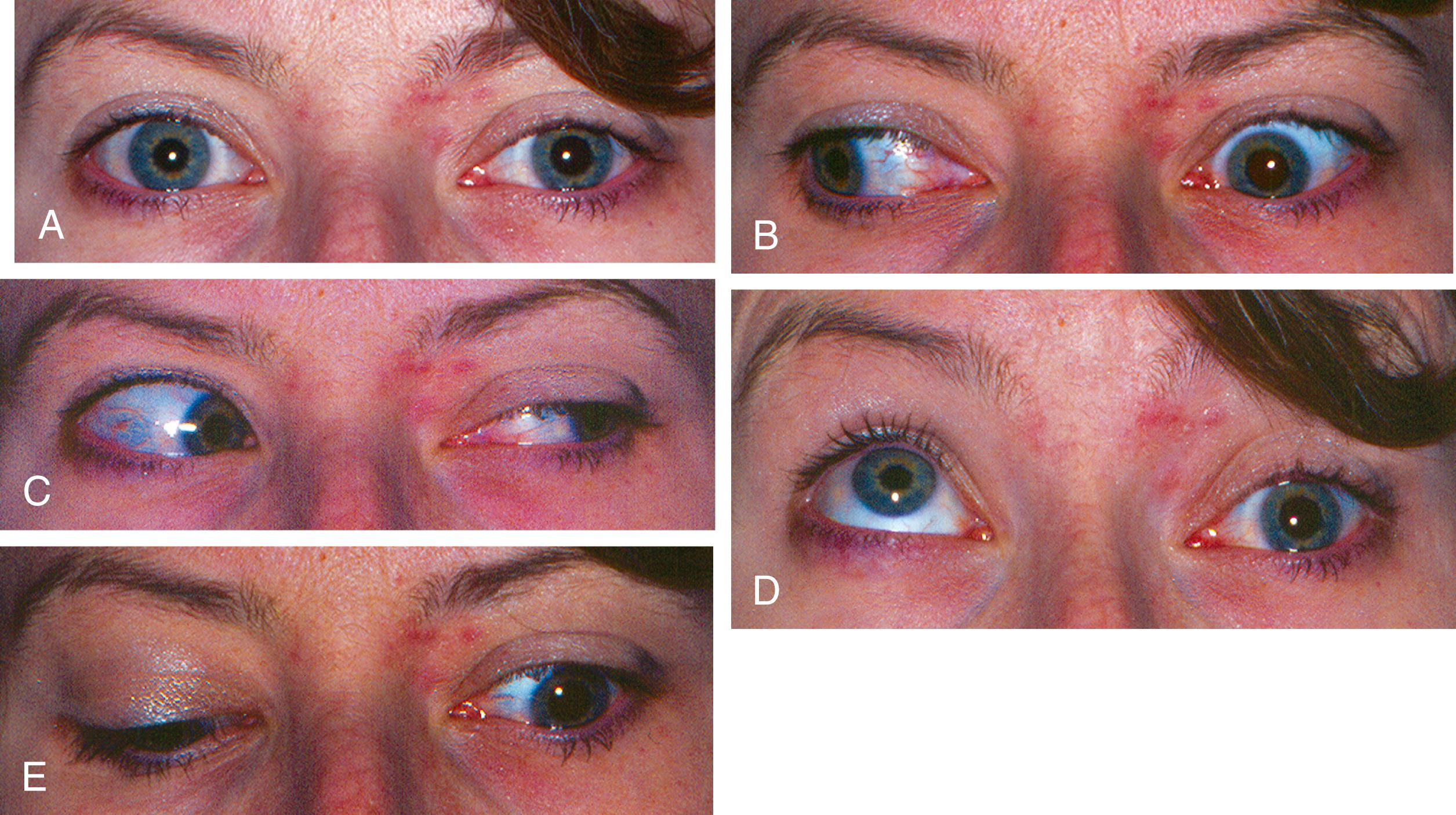
Magnetic resonance angiography (MRA) and computed tomographic angiography (CTA) are the preferred diagnostic tests for aneurysm detection, but it is important to recognize that reliable interpretation of these studies requires a high level of experience, skill, and time ( ; ). The majority of PCOM aneurysms large enough to cause an oculomotor palsy are at least 4 mm in size. For aneurysms larger than 5 mm, the sensitivity of both MRA and CTA are higher than 95%; however, for aneurysms smaller than 5 mm, CTA sensitivity remains above 90% when interpreted by a neuroradiology expert, but MRA sensitivity in some studies is lower, leading some to advocate CTA as the initial diagnostic evaluation for PCOM aneurysms ( ). Neither MRA nor CTA is 100% sensitive, and conventional angiogram is still warranted when strong clinical suspicion for a PCOM aneurysm is present, and noninvasive studies are unrevealing.
Surgical clipping for aneurysms causing oculomotor nerve palsies results in a higher rate of oculomotor recovery compared to endovascular coiling in many (78% for surgery vs. 44% for endovascular coiling in a comparison review of retrospective studies) ( ), but not all ( ) studies. Furthermore, surgery is associated with higher periprocedural morbidity and decisions regarding treatment must take into account patient status, aneurysmal morphology, and treating physician experience ( ). Factors such as initial palsy severity and pretreatment palsy time may also play a role in recovery potential ( ).
In the subarachnoid space, the oculomotor nerve passes in close proximity to the medial temporal lobe. Herniation of the temporal lobe uncus ipsilateral to a space-occupying supratentorial lesion secondary to increased intracranial pressure may result in compression of the oculomotor nerve, manifested clinically as sudden enlargement and poor reactivity of the pupil ipsilateral to the lesion—the Hutchison pupil ( ). Rarely, a unilateral enlarged and poorly reactive pupil may occur contralateral to the supratentorial lesion ( ). Oculomotor nerve involvement in the interpeduncular fossa and subarachnoid space may also occur secondary to inflammatory or neoplastic meningitis, in which case it may be isolated or accompanied by signs of meningeal inflammation such as meningismus or additional neurological signs. Enlargement and enhancement of the oculomotor nerve in the subarachnoid and interpeduncular locations may be seen on magnetic resonance imaging (MRI) in meningitis, with oculomotor nerve schwannomas, in association with ganglioside antibodies such as GQ1b (with persistent or transient oculomotor palsy), and in so-called ophthalmoplegic migraine, a rare condition with recurrent oculomotor paresis and pain usually seen in children (see Chapter 102 ; ; ; ; ; ![]() eFig. 103.4 ).
eFig. 103.4 ).
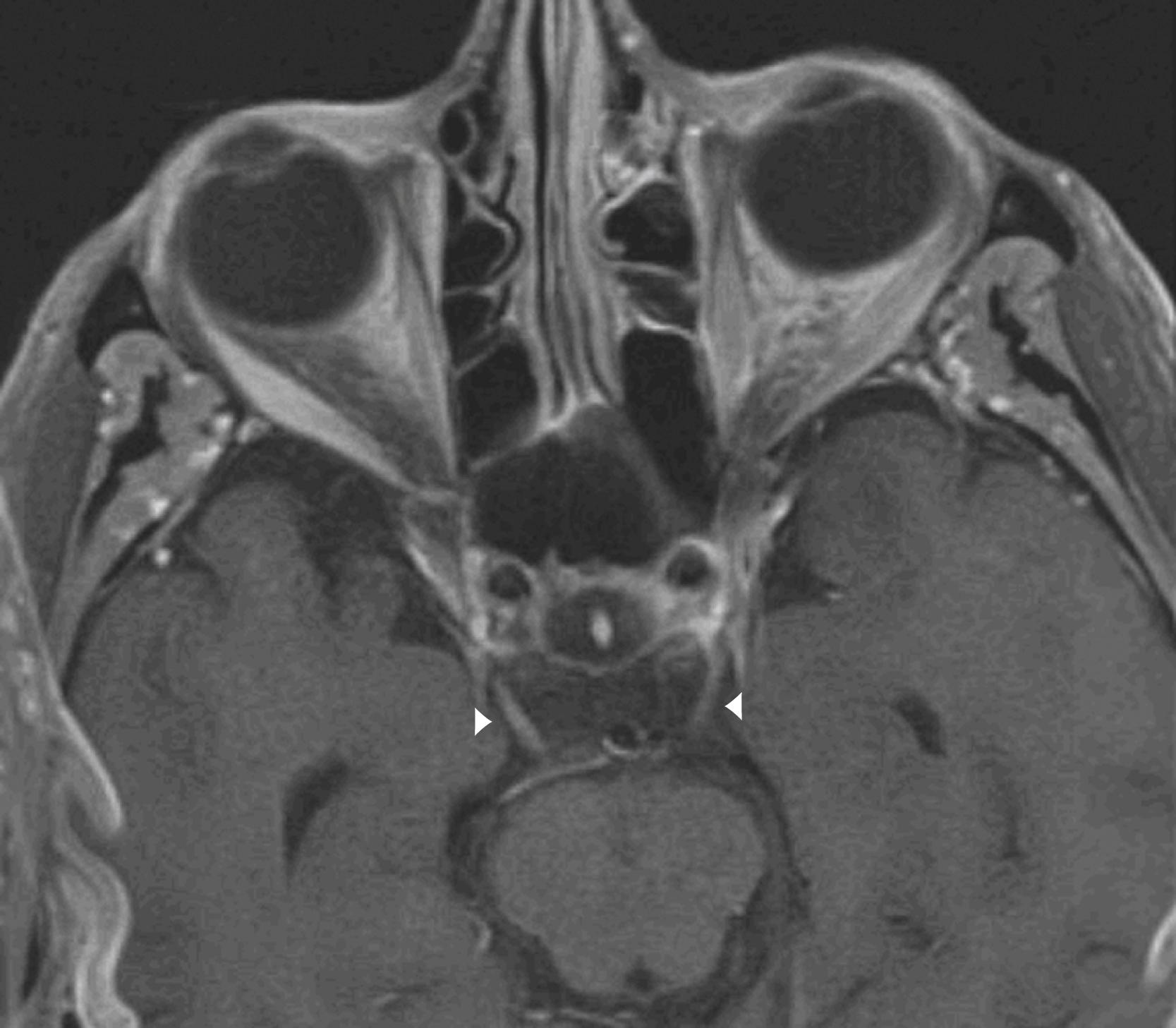
An oculomotor palsy in the cavernous sinus may occur in isolation or accompanied by dysfunction of other structures located in this space, including the abducens and trochlear nerves, the first and second divisions of the trigeminal nerve, and sympathetic fibers. Tolosa-Hunt syndrome is a painful of idiopathic self-limited inflammation of the cavernous sinus, typically responsive to corticosteroids ( ; see Table 103.1 and ![]() , ). Cavernous sinus infiltration by metastatic disease may be clinically and radiographically identical to Tolosa-Hunt syndrome and should be suspected, especially in older patients. Cavernous sinus lymphoma is typically steroid responsive and should be considered, especially if disease recurs with corticosteroid taper. Inflammation associated with systemic rheumatological disease or angioinvasive fungal infection, infiltration from adjacent nasopharyngeal neoplasm, carotid-cavernous fistulas, cavernous sinus thrombosis (more common in the intensive care unit than the outpatient setting), and mass effect from an intracavernous internal artery aneurysm or meningioma may also cause a cavernous sinus syndrome ( ). Pituitary apoplexy should be considered in the differential diagnosis for sudden-onset painful unilateral or bilateral oculomotor palsies, with or without accompanying visual loss or other ocular motor cranial nerve involvement ( ).
, ). Cavernous sinus infiltration by metastatic disease may be clinically and radiographically identical to Tolosa-Hunt syndrome and should be suspected, especially in older patients. Cavernous sinus lymphoma is typically steroid responsive and should be considered, especially if disease recurs with corticosteroid taper. Inflammation associated with systemic rheumatological disease or angioinvasive fungal infection, infiltration from adjacent nasopharyngeal neoplasm, carotid-cavernous fistulas, cavernous sinus thrombosis (more common in the intensive care unit than the outpatient setting), and mass effect from an intracavernous internal artery aneurysm or meningioma may also cause a cavernous sinus syndrome ( ). Pituitary apoplexy should be considered in the differential diagnosis for sudden-onset painful unilateral or bilateral oculomotor palsies, with or without accompanying visual loss or other ocular motor cranial nerve involvement ( ).
Prominent Left Ptosis.
Cranial Neuropathies/Impaired Adduction, Elevation, and Depression With Intact Abduction of the Left Nerve.
Oculomotor dysfunction in the orbital apex is typically accompanied by dysfunction of neighboring structures including the abducens and trochlear nerves, the first division of the trigeminal nerve, and the optic nerve. Features of orbital disease such as proptosis, chemosis, and conjunctival injection may be present. Idiopathic inflammation (orbital inflammatory pseudotumor and immunoglobulin G4 [IgG4]-related inflammation), infection (particularly aspergillosis and mucormycosis in diabetic or immunosuppressed patients), neoplastic infiltration, and inflammation or compression from adjacent sphenoid sinus infection or mucocele should be considered ( ; ). As in cavernous sinus idiopathic inflammation (Tolosa-Hunt syndrome) versus lymphoma, idiopathic orbital inflammatory pseudotumor and lymphoma at the orbital apex are both likely to be steroid responsive, and lymphoma should be considered, especially if pain is absent and if disease recurs with corticosteroid taper. Anatomical division of the oculomotor nerve into superior and inferior branches occurs just before this location, and isolated involvement of either branch is not uncommon.
Isolated oculomotor dysfunction may occur from any lesion along the course of the nerve. Microvascular ischemia, a common cause in older patients with vascular risk factors ( ; ), is typically pupil-sparing; however, relative pupil involvement with an average of 0.8 mm of anisocoria may be seen in up to one-third of patients with microvascular oculomotor nerve ischemia, but the pupil generally remains reactive ( ). Confidence in the absence of a PCOM aneurysm may only be present when all oculomotor-innervated muscles other than the pupil are severely and completely impaired. In this era of modern noninvasive neuroimaging, it is prudent to perform emergent noninvasive vascular neuroimaging for all oculomotor palsies to avoid missing a PCOM aneurysm or other emergent etiology (see above section on Interpeduncular Fossa and Subarachnoid Space). The location of ischemia with a microvascular palsy may be anywhere along the course of the nerve but is typically peripheral and often considered to be in the cavernous sinus, although it is not visible with neuroimaging. Pain in the ipsilateral brow and eye is present in two-thirds of patients and may be severe ( ); however, the presence and characteristics of pain do not distinguish microvascular from aneurysmal oculomotor palsies ( ). Spontaneous resolution over 8–12 weeks is typical for a microvascular etiology. An isolated oculomotor palsy may also arise from temporal arteritis; thus, erythrocyte sedimentation rate (ESR), C-reactive protein, and complete blood cell count (CBC) should be obtained on all elderly patients with an isolated oculomotor palsy and neuroimaging should be considered ( ; ; ). In the absence of complete spontaneous resolution with a suspected microvascular oculomotor palsy, neuroimaging is essential.
Elevation of the eyelid or constriction of the pupil upon adduction or depression of the eye is indicative of aberrant regeneration (anomalous axon innervation). When aberrant regeneration develops following an acute oculomotor palsy, a PCOM artery aneurysm or traumatic etiology is likely (see Fig. 103.3 , B ). When it develops spontaneously without a pre-existing acute palsy, a cavernous sinus meningioma or internal carotid artery aneurysm is likely, although this may also rarely occur with an unruptured PCOM aneurysm. Aberrant regeneration should not occur following a microvascular oculomotor palsy.
Paired trochlear nuclei lie close to the dorsal surface of the midbrain just below the inferior colliculus. The fascicles emerge from the nuclei and course dorsally only 3–9 mm before decussating in the anterior medullary velum, and exiting the brainstem. The trochlear nerves are the only cranial nerves to emerge from the dorsal brainstem surface. After emergence, the nerves wrap around the surface of the midbrain to travel ventrally within the subarachnoid space toward the cavernous sinus. In the cavernous sinus, the trochlear nerve is located in the lateral dural wall, inferior to the oculomotor nerve. From the cavernous sinus, the nerve passes into the superior orbital fissure and ultimately innervates the superior oblique muscle contralateral to the nucleus of origin (see ![]() eFig. 103.1 ). The superior oblique muscle is an intorter of the eye, as well as a depressor of the adducted eye.
eFig. 103.1 ). The superior oblique muscle is an intorter of the eye, as well as a depressor of the adducted eye.
It is difficult to differentiate a trochlear nuclear lesion from a tegmental (ventral and dorsolateral to the periaqueductal gray matter) fascicular lesion prior to the decussation of the fascicle. Both locations will result in paresis of the contralesional superior oblique muscle. Brainstem lesions posterior to the cerebral aqueduct in the tectal (dorsomedial to the periaqueductal gray matter) fascicle after its decussation may give rise to ipsilesional superior oblique paresis ( ). Isolated nuclear or fascicular involvement occurs rarely; it may occur in isolation or in association with other brainstem signs such as Horner syndrome, internuclear ophthalmoplegia, or cerebellar ataxia. Brainstem lesions include ischemia, hemorrhage, demyelination, infectious and noninfectious inflammation, and neoplasm ( ; ).
Trochlear nerve dysfunction results in impaired intorsion of the eye, impaired depression of the adducted eye, elevation of the affected eye (hypertropia), and vertical or oblique diplopia. The diplopia and hypertropia are worse with downgaze when the eye is in an adducted position, as this is the direction of action of the superior oblique muscle. Impaired depression of the affected eye in the adducted position may be seen but is often subtle ( Fig. 103.5 ). A resting head tilt in the direction away from the paretic eye (e.g., right trochlear palsy, left head tilt) may be present and is considered a sign of chronicity. Because the superior oblique is an intorter of the eye, diplopia is minimized when a contralateral head tilt places the affected eye in an extorted position. The Parks-Bielschowsky three-step test (see Chapter 18 for additional information) is an examination technique utilized to assess the diplopia and hypertropia for conformation to the “pattern of a trochlear palsy” and consists of assessment of (1) which eye is hypertropic, (2) whether the hypertropia is worse in right or left gaze, and (3) whether the hypertropia is worse in right or left head tilt. The pattern of a fourth is a hypertropia on the side of the trochlear palsy, worsening in the contralateral gaze direction and upon ipsilateral head tilt ( ). A fourth step is assessment of the hypertropia in the upright versus supine position; reduction in size of the hypertropia in the supine position suggests a skew deviation, given gravity dependence of the otolith vestibular organs ( ; ).
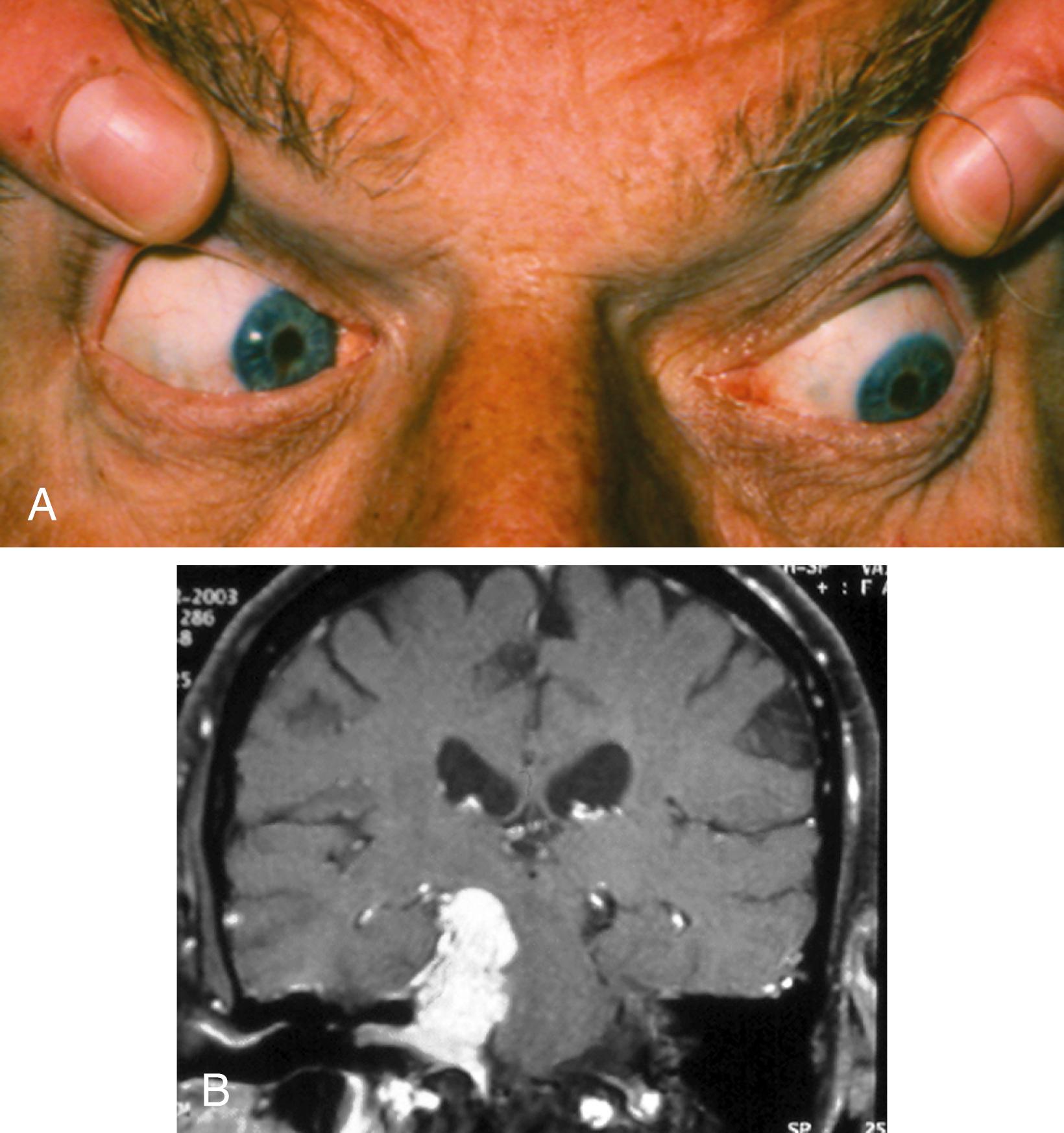
Evaluation for superior oblique paresis in the setting of oculomotor nerve dysfunction with impaired adduction from medial rectus paresis is best assessed with the affected eye in an abducted position, where intact intorsion during downgaze suggests intact trochlear function.
Within the subarachnoid space, the nerves are near the tentorium cerebelli and are prone to unilateral or bilateral traumatic injury ( ). Unlike traumatic oculomotor palsy, which usually occurs following severe head trauma with loss of consciousness, the trochlear nerves are injured more easily by minor degrees of head trauma ( ).
Trochlear nerve involvement in isolation or accompanied by signs of meningeal inflammation, such as meningismus, or additional cranial nerve palsies, may occur secondary to inflammatory or neoplastic meningitis. Enhancement of the nerve as it travels around the midbrain may be present on MRI. An increasingly recognized cause of such enhancement in the setting of normal cerebrospinal fluid is trochlear nerve schwannoma ( ; ; ![]() eFig. 103.6 ).
eFig. 103.6 ).
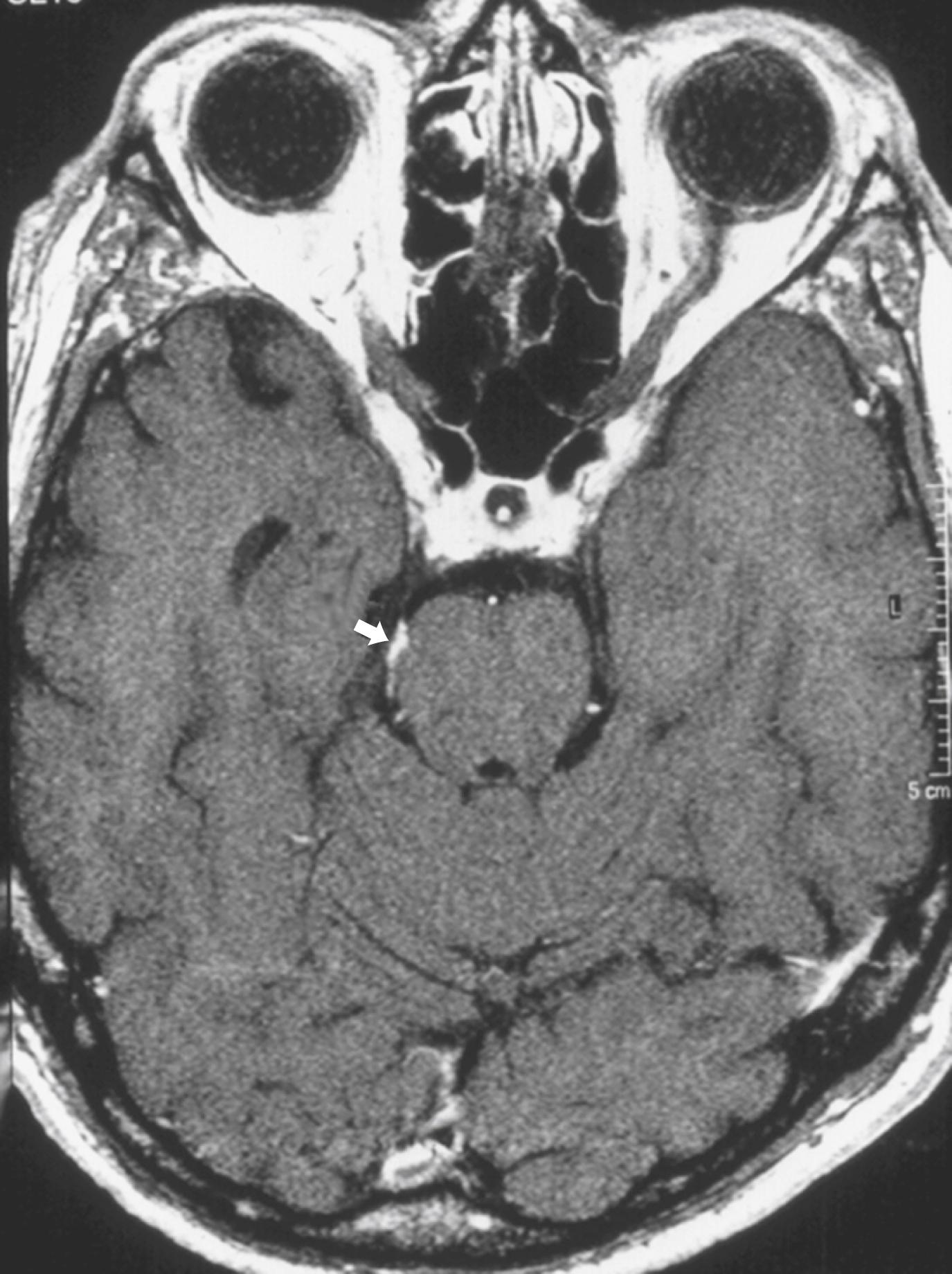
Trochlear palsy in the cavernous sinus is generally accompanied by dysfunction of other structures including the abducens and oculomotor nerves, the first and second divisions of the trigeminal nerve, and sympathetic fibers. Idiopathic inflammation, inflammation associated with systemic rheumatological disease or angioinvasive fungal infection, infiltration from adjacent nasopharyngeal neoplasm, carotid-cavernous fistulas, and mass effect from an intracavernous internal artery aneurysm or meningioma are common causes. Pituitary apoplexy very rarely, if ever, results in isolated trochlear paresis ( ).
See Orbital Apex section above under Oculomotor Nerve, Clinical Lesions.
Congenital, traumatic, and microvascular ischemic trochlear palsies are common causes of neurologically isolated trochlear paresis ( ; ; ). Identification of a long-standing head tilt in old photographs of the patient and increased vertical fusional amplitudes (a test of the amount of image misalignment with which the individual can maintain binocular fusion—tends to be high with congenital lesions) can help confirm the diagnosis of a congenital trochlear nerve palsy. Overaction of the inferior oblique muscle, manifested by excessive elevation upon adduction of the eye ipsilateral to the trochlear weakness, and hypertropia worsening in upgaze rather than downgaze may also suggest a congenital etiology ( ; ).
The trigeminal nerve consists of afferent sensory, efferent motor, and parasympathetic fibers. The ophthalmic (V1), maxillary (V2), and mandibular (V3) trigeminal sensory nerve branches emerge from the anterior surface of the trigeminal (gasserian) ganglion in the Meckel cave (a dural cavity overlying the apex of the petrous bone) and innervate the facial skin, mucous membranes of the nose and mouth, teeth, orbital contents, and supratentorial meninges ( Fig. 103.7 ; also see ![]() eFig. 103.1 ). The ophthalmic division courses in the lateral wall of the cavernous sinus inferior to the trochlear nerve and exits the skull via the superior orbital fissure. It is the anatomical substrate for the afferent limb of the corneal reflex. The maxillary division also courses in the lateral wall of the cavernous sinus, exiting the skull via the foramen rotundum to enter the sphenopalatine (also called the pterygopalatine) fossa and the inferior orbital fissure. The mandibular division exits the skull through the foramen ovale. Sensory input from these three branches travels centrally from the trigeminal ganglion via the trigeminal sensory root in the prepontine subarachnoid cistern to the trigeminal sensory nucleus, which is composed of a mesencephalic subnucleus receiving proprioceptive input from V3, a principal (main) sensory subnucleus mediating tactile sensation, and descending spinal subnuclei (oralis, interpolaris, and caudalis) that descend to the cervical spinal cord and mediate pain and temperature. Sensory information ultimately ascends to the contralateral thalamus.
eFig. 103.1 ). The ophthalmic division courses in the lateral wall of the cavernous sinus inferior to the trochlear nerve and exits the skull via the superior orbital fissure. It is the anatomical substrate for the afferent limb of the corneal reflex. The maxillary division also courses in the lateral wall of the cavernous sinus, exiting the skull via the foramen rotundum to enter the sphenopalatine (also called the pterygopalatine) fossa and the inferior orbital fissure. The mandibular division exits the skull through the foramen ovale. Sensory input from these three branches travels centrally from the trigeminal ganglion via the trigeminal sensory root in the prepontine subarachnoid cistern to the trigeminal sensory nucleus, which is composed of a mesencephalic subnucleus receiving proprioceptive input from V3, a principal (main) sensory subnucleus mediating tactile sensation, and descending spinal subnuclei (oralis, interpolaris, and caudalis) that descend to the cervical spinal cord and mediate pain and temperature. Sensory information ultimately ascends to the contralateral thalamus.
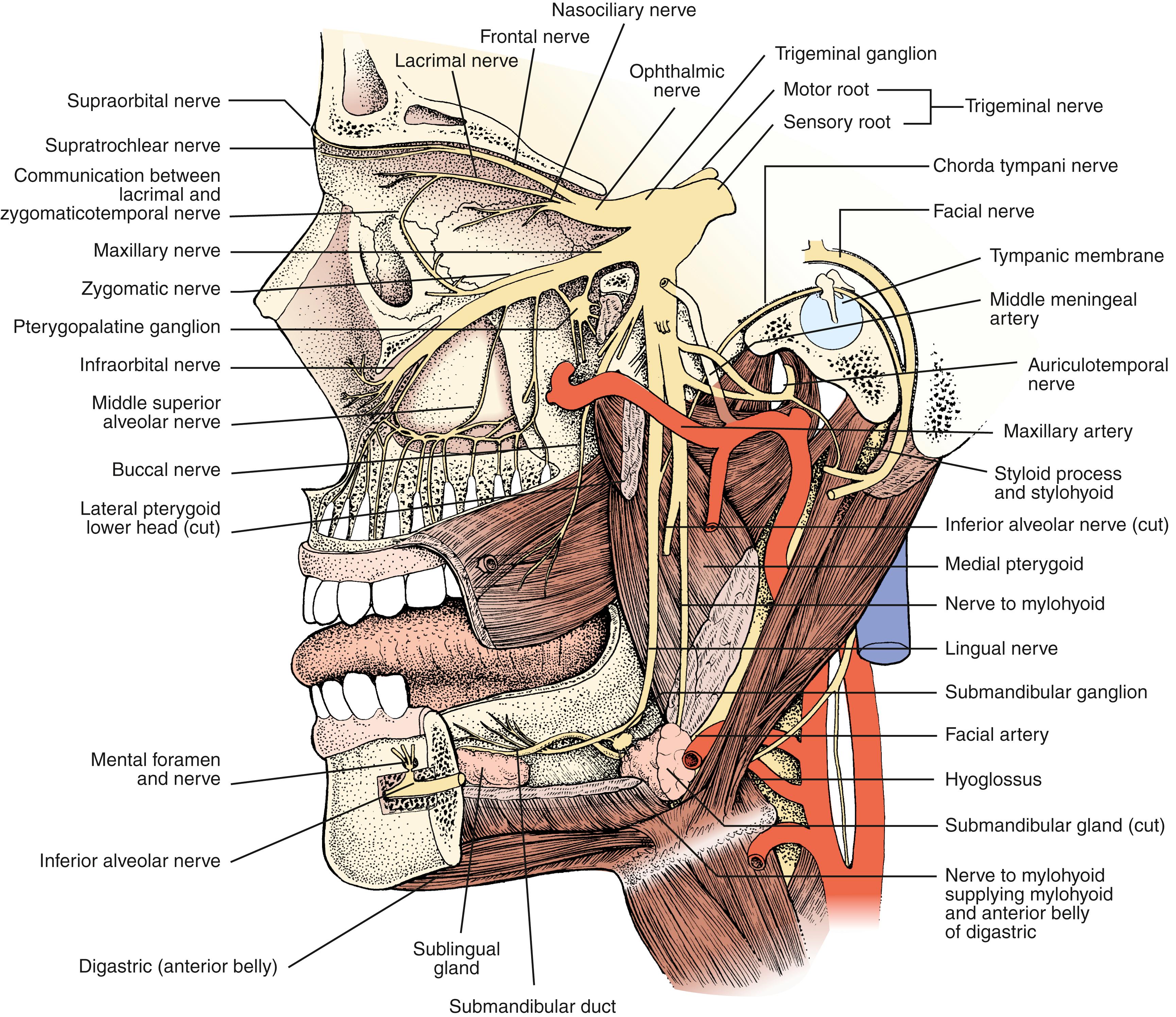
The motor efferents originate in the motor trigeminal nucleus in the pons, medial to the principal sensory nucleus, emerge from the ventral pons as the motor root, travel inferior to the trigeminal ganglion and then alongside the mandibular sensory division to innervate the muscles of mastication (masseter, temporalis, pterygoids) and the mylohyoid, tensors tympani and palatini, and anterior belly of the digastric. Trigeminal nerve branches carry efferent postganglionic parasympathetic innervation from the pterygopalatine ganglia to the lacrimal gland and from the submandibular ganglia to the salivary glands. Preganglionic parasympathetic fibers travel in the facial nerve.
The extension of the trigeminal nuclear complex throughout the entire brainstem renders it susceptible to involvement from any pathological brainstem process. Trigeminal lesions are particularly common with demyelinating disease, may involve either the nuclei or sensory root, and may be clinically silent or symptomatic ( ; ). Ischemia, hemorrhage, infectious and noninfectious inflammation, and neoplasm are other causes of trigeminal brainstem involvement ( ). Additional brainstem signs are frequently present. Wallenberg syndrome from lateral medullary ischemia typically causes ipsilateral facial numbness and impaired pinprick sensation secondary to descending spinal tract and nucleus involvement (see Table 103.1 ).
Become a Clinical Tree membership for Full access and enjoy Unlimited articles
If you are a member. Log in here